
views
X
Research source
Choosing Phases and Levels to Benchmark

Determine the demographics of your target customers. Create a profile of your ideal customer, including their age range, gender identity, profession, and average income. Depending on the nature of your products or services, you might also include other interests or personality traits. Then try to think of other people to whom your products would also appeal. For example, suppose you have a mobile dog grooming business. You may decide that your ideal customer is a busy young urban professional who lives an active lifestyle and values convenience. However, since you come directly to your clients, elderly pet owners who are homebound might also be interested in your services.

Evaluate the economy in the area where you operate. Ideally, you want your business to be situated in an area where there are plenty of people who fit the profile of your ideal customer. An area with a relatively stable economy provides the most opportunities for growth. To return to the mobile dog grooming business example, if you wanted to target active young urban professionals, you would want to be located in a medium-to-large city with a booming economy. Even if you're in the right type of area, it won't help you if the area is currently going through a recession, or if there is political unrest.

Make projections of future trends in your industry. Trade publications and articles online by industry watchers can help you determine what your customers of the future are going to be interested in. You can also look at trending topics on social media. For example, if people in your demographic express concern for the environment, you might look into buying hybrid or electric vehicles for your business, or using environmentally friendly products.

Develop surveys and questionnaires for your customers. Surveys of existing customers help you identify what you're doing right as well as highlighting areas where you might be able to improve your service. They can also give you an idea of what additional services your customers might be interested in. Include scale rating questions as well as open-ended questions that give your customers the opportunity to express their feelings and make suggestions about ways you can improve. Use targeted, specific questions that relate directly to the research you've already done on your demographic, the local economy, and trends in your industry. For example, if you've noticed a trend towards environmentally friendly products in the pet care industry, you might include a question for your customers that says "On a scale of 1 to 5, how important is it for you that the products we use to groom your pet are environmentally friendly?" Try to keep your survey short enough that it can be answered in 2 to 5 minutes. If you make it much longer than that, you may have a lot of people who don't complete it. You might also consider offering your customers something for completing the survey, such as 10 percent off their next purchase from you.Tip: Online services, such as Google Apps or SurveyMonkey, can help you easily design a survey, send it to your customers, and collect the data.
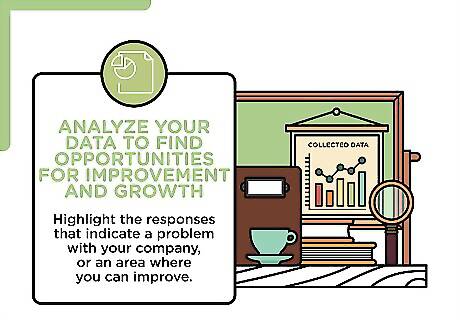
Analyze your data to find opportunities for improvement and growth. Once you have the answers from your surveys, look at the interests of your customers and their responses to your questions. Highlight the responses that indicate a problem with your company, or an area where you can improve. You might also find that your customers would be interested in additional services that you don't yet provide. To continue with the example of the mobile dog grooming business, perhaps a significant number of customers indicated on your survey that they were interested in dog massage. If that isn't a service you currently offer, you might want to consider hiring an animal massage therapist.

Set performance and service goals for your business based on your analysis. Choose the areas where you want to focus and determine what you want your goal to be and when you expect that goal can be achieved. You may have to do some additional research before you can set your preliminary goals. For example, if you want to add massage to the services offered by your mobile dog grooming business, it might help to know how many animal massage therapists were available in your area, as well as what is involved in the typical animal massage session. Then you can decide when you could roll out this service and how much you should charge. You might also have goals to improve performance. For example, if many customers of your mobile dog grooming business had indicated your groomers frequently showed up late, you might set a goal to improve the efficiency and punctuality of your groomers by installing GPS systems in the grooming vehicles.
Collecting Data on Competitors and Market Trends

Make a list of your major competitors. Typically your major competitors are going to be other companies in the same industry as you. They may not offer exactly the same services, but they are companies your customers could turn to instead of your company. For example, if you have a mobile dog grooming business, your competitors generally will be other dog grooming businesses. You may be the only mobile dog grooming business in your area, but that doesn't mean you don't have competition from dog groomers who operate out of brick-and-mortar stores. You might also consider businesses in the same broad industry that don't offer similar services. Suppose there's a brick-and-mortar shop in your area that provides clean grooming facilities and tools for people to groom their own dogs. They would be considered a competitor of your mobile dog grooming business, even though they don't offer professional grooming services.

Gather a project team to handle the benchmarking study. Select executives or members of management who have experience in conducting market research and analyzing market data. Ideally, you want people who aren't involved in the day-to-day operations of the business, since they'll likely devote a lot of time toward this project. You also want to include people at lower levels on your project team, as their on-site observations may prove critical. To continue the mobile dog grooming business example, you would want to have at least one professional groomer who could evaluate the grooming skills and sanitation methods of other groomers. If you don't have enough staff to build a project team in-house, you might consider hiring an independent firm to conduct your benchmarking study. Check at your local small business association to identify professionals who could help you with this.

Contact your competitors to invite them to share data. Send a written invitation to each of your competitors to participate in your study. Outline the exact areas you're evaluating, your goals for the study, and the types of data you'll need. For example, if you're contacting other dog groomers, you might want information on the grooming products they use, the average time of grooming appointments, the cost of their services, and the types of other services they provide to their customers. Although you may be able to get much of this information on your own, for example by posing as a customer, it's generally considered more respectful to be open about why you want the information and what you're going to do with it. This can be the trickiest part of benchmarking, because competitors may be reluctant to share data. They may believe keeping information about their business secret gives them an edge. They may also be afraid that sharing data will expose problems or weaknesses in their business.Tip: Typically, you have to be willing to share your own data to get competitors to share theirs. They may also want to see the results of your benchmarking study.
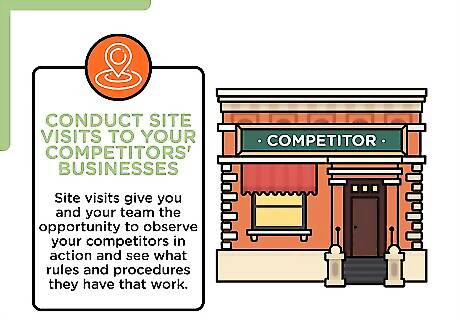
Conduct site visits to your competitors' businesses. Site visits give you and your team the opportunity to observe your competitors in action and see what rules and procedures they have that work (and what doesn't work). Take note of things that might be helpful in your own business. For example, you might visit one dog groomer that has an assistant come in after each grooming appointment to clean and sterilize the room, instead of the groomer doing it. This way, the groomer can quickly move to another appointment without spending time cleaning. Additionally, the business doesn't have to pay the assistant as much as the professional groomer, which cuts costs. After each site visit, write up a brief report summarizing your observations. Relate your observations back to your original goals, comparing your competitors' performance to your own.
Creating an Action Plan

Present your results to management and company leaders. Once you've collected all the information from your competitors, compile it into a brief presentation for the heads of the company. Let them know what you've learned as well as how these observations apply to your own business. Compare your business to its competitors and include a list of things you're doing better than your competitors and things that could be improved. Typically, a slide presentation works well for this. You might also include a brief written handout that summarizes the conclusions of the study.
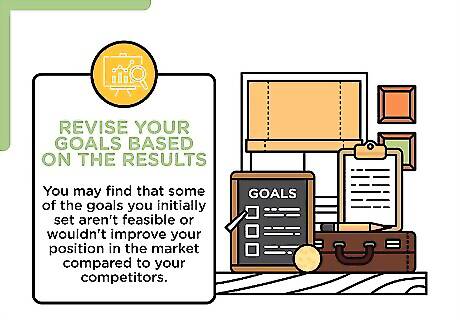
Revise your goals based on the results of your benchmarking study. Once you learn the results of your study, you may find that some of the goals you initially set aren't feasible or wouldn't improve your position in the market compared to your competitors. You might also find some that could be implemented more easily than you thought. For example, suppose you initially decided to transition to organic and environmentally friendly products for your mobile dog grooming business. You discovered that one of your competitors offers this service, and their supplies actually cost less than the supplies you're currently using. This is a goal that might be more easily implemented than you originally suspected. On the other hand, you may have determined that offering animal massage to your mobile grooming clients isn't feasible because there isn't enough space in your mobile units to accommodate a basic massage therapy session.
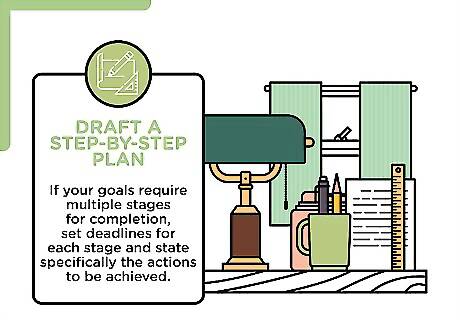
Draft a step-by-step plan to achieve your goals. If your goals require multiple stages for completion, set deadlines for each stage and state specifically the actions to be achieved. Each deadline should be attached to a quantifiable step towards the ultimate goal. For example, if you're going to switch to organic, environmentally dog grooming supplies, you likely want to use up the supplies you have first. You would check the quantities of the supplies you have and the average amount used to set the deadline for using up all the old products. Then you would set a deadline about a month before that one to cancel with the old vendor and contract with the new one. You would have an additional step for advertising the new products and notifying your customers of the change.

Work with management to implement your plan. Everyone in your business who is involved in the plan is responsible for ensuring the deadlines are met. You can empower employees lower down the chain to take steps where necessary to advance progress towards the goal. For example, the switch to environmentally friendly supplies in your mobile dog grooming business would require assistance from the groomers as well as customer service staff. Groomers could promote additional services to customers that would help use up old products more quickly, and customer service could inform customers of the change. Educate all of your employees, particularly those who deal directly with the customers, about the improvements being made. They can let your customers know that these changes are being made in response to their feedback.
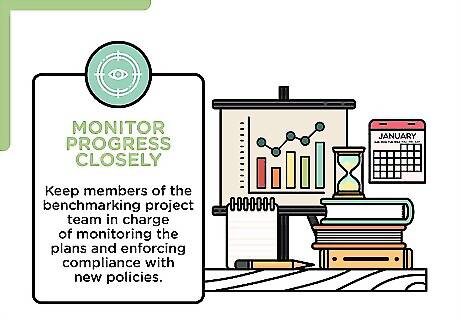
Monitor progress closely and adjust your action plan as needed. Keep members of the benchmarking project team in charge of monitoring the plans and enforcing compliance with new policies. They can evaluate progress and determine whether deadlines can be met. Get regular status reports from your team so you know where the various plans stand and whether any challenges have come up that need to be addressed.


















Comments
0 comment